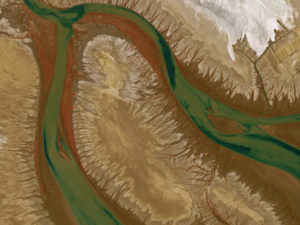LETTER FROM THE PUBLISHER

Myrna James Yoo Publisher and Managing Editor Apogeo Spatial and LBx Journal Owner Blueline Publishing LLC Myrna@ApogeoSpatial.com
Dear Readers,
In this issue, we are continuing our series,“Filling the Gap”… that is, the gap that will be left when Google ends support for Google Earth Enterprise (GEE) on March 22, 2017. (The Google Earth API and Google Maps Engine are also no longer supported. Google is clearly still committed to Google Earth Engine and other products, which we will cover in a future issue.) The genesis of this series was to offer users of GEE many options for the future, signs for your roadmap, a sense of a new direction.
In Fall 2015, we covered Esri’s ArcGIS Earth, and VRICON’s Globe in 3D. In Winter 2016, we featured Galdos Systems’ INdicio, Skyline Software’s SkylineGlobe and TerraExplorer, as well as Onix Networking Corp., which integrates Skyline’s software into organizations’ IT systems. In this issue, we add CartoDB and a bit about DigitalGlobe (more to come in Summer), and we also asked experts from the National Geospatial-Intelligence Agency to weigh in. Read the article here.
We are excited to continue this series, because it is applicable for all readers, whether you have used GEE or not. We are summarizing many different product and service offerings for analyzing and visualizing geospatial data and tools, ongoing. While some of these companies offer global visualization and the ability to embed proprietary data on a 3D globe similar to GEE, others offer platforms or basemaps that allow users to go deeper into a stack of imagery and data, without the global “view.” In future issues, we will cover Cesium, Mapbox, iSpatial, Ubisense, Hexagon, Pitney Bowes… and more.
All of the satellite imaging companies are now building their own digital “platforms,” to provide easier access to their immense archives of imagery, both historical and current, for experts and non-experts alike. Their products are not identical, of course; we will help you understand the points of differentiation.
In this issue, not a moment too soon, Apogeo Spatial is finally featuring the innovative satellite Earth imaging company, Planet Labs. The company was founded in 2010 by a team of ex-NASA scientists (several of whom were students of Apogeo Spatial editor Ray Williamson, when he was teaching at George Washington University, or at the International Space University). The mission is to image the entire Earth every day, and make global change visible, accessible, and actionable. They started as a small team of physicists, and aerospace and mechanical engineers in a garage (pictured here), using the cubesat form-factor to inform the first designs of the Dove satellite. Read our interview with Planet Labs’ co-founder Robbie Schingler and VP of Global Impact Initiatives Andrew Zolli here.
While DigitalGlobe is included in this, our 3rd installment of the series, “Filling the Gap,” it should be noted that the Summer issue will provide more information on how their new Geospatial Big Data Platform (BGDX) and Maps API will meet the needs of some customers. We will speak further with John-Isaac Clark, who provides insight, and who muses on his blog (http://bit.ly/1So63uv):
“Sir Arthur C. Clarke’s statement that ‘any sufficiently advanced technology is indistinguishable from magic’ may one day be followed up by the corollary statement that ‘any sufficiently advanced technology is not identifiable as technology.’ In other words, for technology to be truly transformative, it first must become so accessible that anyone can use it without understanding that it is, in fact, advanced technology.”
Finally, after many years of discussions and unused licenses and false starts, and after a decade of organizations relying on Canadian and Italian commercial Synthetic Aperture Radar (COMSAR) satellites, a few U.S. companies are planning to launch COMSAR satellites. Plans for XpressSAR are discussed here, with a quick glance at the history of U.S. policy (or lack thereof) for COMSAR.



